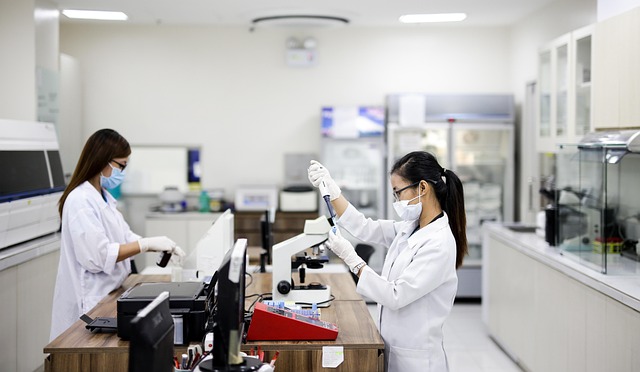Medical offices face unique workers' compensation challenges due to specialized tasks and risks. Adequate medical office workers comp insurance is crucial for compliance, safety, and operational efficiency. It covers RSI, patient handling, and infectious disease exposure, offering financial protection and mitigating legal issues. Choosing the right insurer with specialized healthcare policies ensures local regulation adherence and builds trust among employees. Seamless claims processes and proactive safety culture through training and communication enhance workplace safety and patient care quality.
“In the dynamic landscape of healthcare, ensuring compliance-ready workers’ compensation (WC) coverage is paramount for clinics. This comprehensive guide navigates the intricate web of WC requirements tailored specifically for medical offices. From understanding industry-specific risks to choosing the optimal insurance policies, we demystify the process. Learn how fostering a robust safety culture not only enhances prevention but also solidifies compliance. Embrace best practices for managing claims and discover strategies to keep your clinic’s WC program streamlined and effective.”
- Understanding Workers Comp Requirements for Clinics
- The Importance of Compliance in Medical Offices
- Common Risks and Injuries in Healthcare Settings
- Choosing the Right Workers Comp Insurance for Clinics
- Navigating Claims Process: Tips for Clinic Staff
- Enhancing Safety Culture for Prevention and Compliance
Understanding Workers Comp Requirements for Clinics

Medical offices, including clinics, have unique workers’ compensation (workers comp) requirements due to their specialized nature and potential risks. These regulations are in place to protect employees and ensure a safe work environment. When it comes to compliance-ready medical office workers’ comp, understanding these mandates is paramount for businesses to avoid legal pitfalls and maintain a positive reputation.
Employers must familiarize themselves with state-specific laws governing workers’ compensation insurance. Coverage for medical professionals involves addressing specific injuries related to their duties, such as repetitive strain injuries from prolonged patient care or accidents resulting from navigating busy clinic settings. Staying informed about these requirements ensures that the clinic’s workers comp policy aligns with industry standards, fostering a culture of safety and compliance among employees.
The Importance of Compliance in Medical Offices

In the competitive landscape of healthcare, ensuring compliance with regulations is non-negotiable for medical offices, including clinics. Medical office workers comp plays a pivotal role in safeguarding both employees and employers from potential risks and liabilities associated with workplace injuries or illnesses. It’s not just about meeting legal requirements; it’s a strategic move to foster a culture of safety and well-being within the clinic.
Compliance-ready workers comp is designed to protect medical offices from financial setbacks, reputational damage, and legal battles that can arise from non-compliance with workers’ compensation laws. By staying up-to-date with regulations and offering comprehensive coverage tailored to the unique needs of healthcare professionals, clinics can minimize disruptions, maintain operational efficiency, and ultimately provide better patient care.
Common Risks and Injuries in Healthcare Settings

In healthcare settings, such as medical offices and clinics, several unique risks and injuries can occur due to the nature of patient care activities. One of the most prevalent dangers is repetitive strain injuries (RSIs), often experienced by staff who perform tasks like typing, filing, or using medical equipment repeatedly. These RSIs, affecting muscles, tendons, and joints, are a significant concern in medical offices and can lead to long-term disabilities if not addressed promptly.
Another common risk is injury from patient handling, especially when moving or transferring patients, which can result in musculoskeletal disorders. Additionally, healthcare workers are at higher risk of exposure to infectious diseases, requiring proper training and protocols for infection control. Medical office workers comp insurance plays a crucial role in mitigating these risks by providing financial protection and coverage for medical expenses, lost wages, and legal fees associated with workplace injuries or illnesses.
Choosing the Right Workers Comp Insurance for Clinics

When it comes to insuring your clinic’s workforce, selecting the appropriate medical office workers comp insurance is paramount. It’s not just about covering injuries or illnesses; it’s also about ensuring compliance with local regulations and providing peace of mind for both employees and employers. Look for insurers that offer policies tailored specifically for healthcare providers, as these often account for unique risks associated with clinical settings.
Consider factors like coverage limits, policy exclusions, and the insurer’s reputation for handling claims efficiently. A reputable provider should be able to guide you through the complex landscape of workers comp regulations, ensuring your clinic meets all necessary requirements. Remember, the right insurance isn’t just a safety net; it’s an investment in your clinic’s long-term sustainability and the well-being of your employees.
Navigating Claims Process: Tips for Clinic Staff

Navigating the claims process is a crucial aspect of ensuring smooth operations in a clinic. Medical office workers comp claims can be complex, but with the right preparation and understanding, staff can play a vital role in this process. Firstly, educate yourself about the specific medical office workers comp policies and procedures relevant to your clinic. This includes knowing the reporting deadlines for injuries or illnesses, as well as the documentation requirements.
Encourage staff members to report any work-related incidents promptly and accurately. They should be familiar with the necessary forms and the step-by-step process of filing a claim, including gathering evidence and medical records. Regular training sessions on workers comp best practices can help demystify this process for employees, ensuring they feel supported and empowered when dealing with potential claims.
Enhancing Safety Culture for Prevention and Compliance

In today’s digital era, medical office workers comp is more than just insurance; it’s a cornerstone of a robust safety culture. Enhancing this culture within clinics isn’t just about mitigating risks; it’s about fostering an environment where prevention is prioritized. By implementing clear protocols and regular training for staff, clinics can ensure that everyone from receptionists to nurses understands their role in maintaining a safe work environment. This proactive approach not only reduces the likelihood of workplace injuries but also aligns with regulatory requirements, making compliance-ready workers comp a game-changer.
A key aspect of this transformation is encouraging open communication where employees feel comfortable reporting hazards or near misses without fear of reprisal. This creates a culture of continuous improvement where lessons learned are shared and acted upon. Leveraging technology for safety, such as implementing digital systems that streamline safety procedures and provide real-time data on incident trends, further strengthens the clinic’s safety posture. Ultimately, these efforts contribute to a safer workplace, improved patient care, and better compliance with medical office workers comp regulations.
